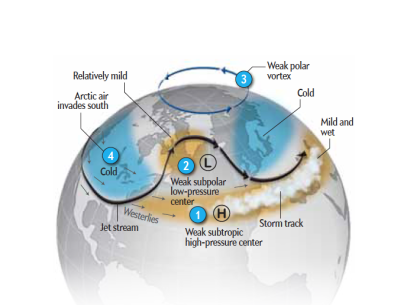Science Source
Linking Siberian Snow Cover to Precursors of Stratospheric Variability
- Mentions previous research that has linked wintertime Arctic Oscillation (AO) variability to indices of Siberian snow cover and upward wave activity flux in the preceding fall season
- Presents daily data used to examine the surface and tropospheric processes that occur as the link between snow cover and upward forcing into the stratosphere develops
- Finds that October Eurasian mean snow cover is significantly related to sea level pressure (SLP) and to lower-stratosphere (100 hPa) meridional heat flux
- Analyzes daily SLP and 100-hPa heat flux which shows that in years with high October snow, the SLP is significantly higher from approximately 1 November to 15 December, and the 100-hPa heat flux is significantly increased with a two-week lag, from approximately 15 November to 31 December
- Finds that during November–December, there are periods with upward wave activity flux extending coherently from the surface to the stratosphere, and these events occur nearly twice as often in high snow years compared to low snow years
- Finds the vertical structure of these events is a westward-tilting pattern of high eddy heights, with the largest normalized anomalies near the surface in the same region as the snow and SLP changes
- Results suggest that high SLP develops in response to the snow cover and this higher pressure, in turn, provides part of the structure of a surface-to-stratosphere wave activity flux event, thus making full events more likely
Related Content
Headline

Apr 12, 2016 | Scientific American Blog Network
What Is This Polar Vortex That Is Freezing the U.S.?
Science Source
| Science
The Siberian snow connection
Carolyn Gramling
Science Source
| Nature Geoscience
Recent Arctic amplification and extreme mid-latitude weather
Judah Cohen, James A. Screen, Jason C. Furtado et al
Science Source
| Environmental Research Letters
Evidence for a wavier jet stream in response to rapid Arctic warming
Jennifer A Francis, Stephen J Vavrus


